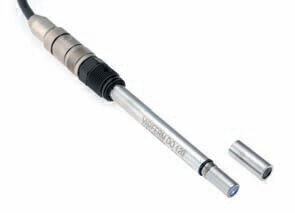Chromatography
Oxygen Measurement with a Blue Light
Jul 29 2009
The VISIFERM™ DO oxygen sensor from Hamilton Bonaduz AG beams out blue light that serves for the measurement of the oxygen content of fluids or gases. The measurement principle is based on the fact that certain materials - so-called luminophores - absorb blue light and emit red light. The luminophore in the VISIFERM™ DO is hit by a succession of blue light pulses. When the luminophore is in contact with oxygen, then the higher
the oxygen pressure in the environment, the more the maximums of the radiated red light pulses approach those of the blue light.
The blue and red light pulses are measured by a photo diode. From the shift of the two light pulses to one another, the photodiode produces a signal that represents the value of the oxygen partial pressure in the measurement environment. The strengths of the VISIFERM™ DO in everyday practice are very much due to this measurement method. Most importantly, the signal that the sensor produces does not change as the luminophore wears. For this reason, the VISIFERM™ DO seldom has to be calibrated. Furthermore, the sensor itself consumes no oxygen during the measurement. VISIFERM™ DO can therefore perform precise measurements in static fluids.
Digital Edition
Lab Asia Dec 2025
December 2025
Chromatography Articles- Cutting-edge sample preparation tools help laboratories to stay ahead of the curveMass Spectrometry & Spectroscopy Articles- Unlocking the complexity of metabolomics: Pushi...
View all digital editions
Events
Jan 21 2026 Tokyo, Japan
Jan 28 2026 Tokyo, Japan
Jan 29 2026 New Delhi, India
Feb 07 2026 Boston, MA, USA
Asia Pharma Expo/Asia Lab Expo
Feb 12 2026 Dhaka, Bangladesh



















